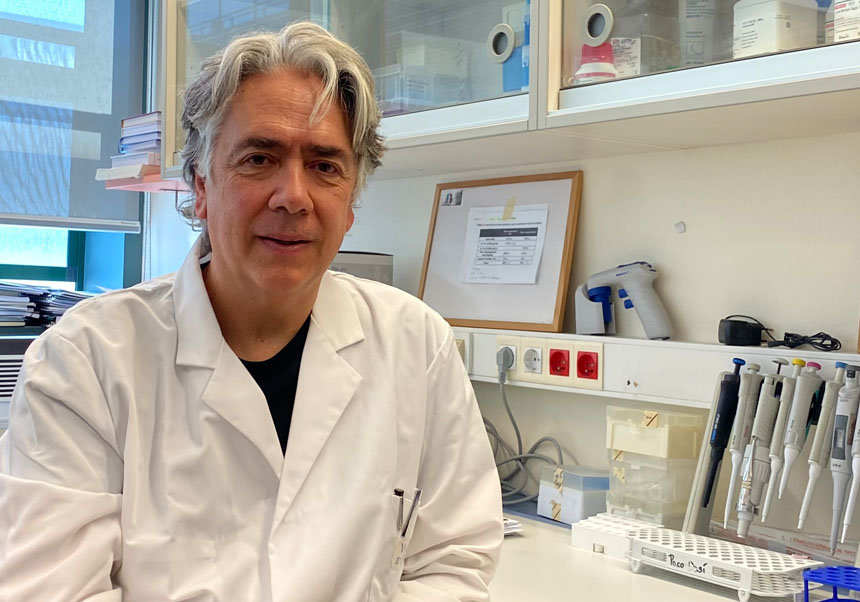A study explains the molecular basis of primary ciliary dyskinesia (PCD), a rare respiratory disease
- Scientific Culture and Innovation Unit
- April 18th, 2024

A study by the Rare Respiratory Diseases research group of the University of Valencia (UV) and the INCLIVA Health Research Institute, the La Fe Health Research Institute and the CEU-Cardenal Herrera University explains the molecular foundations of primary ciliary dyskinesia (DCP). It is a rare respiratory disease whose symptoms in children are rhinitis, sinusitis and productive cough with recurrent or chronic infections of the respiratory tract, recurrent middle ear infection and in adults the development of bronchiectasis, dilations of the bronchi that cause infections.
The research, led by Francisco Dasí, professor of the Department of Physiology (UV) and coordinator of the Research Group on Rare Respiratory Diseases (ERR) of INCLIVA, has been published in the journal Antioxidants. The work, funded by the Spanish Society of Pediatric Pulmonology, the Valencian Society of Pulmonology and with European FEDER funds, involves the determination of the oxidative profile in nasal epithelial cells from patients with PCD, specifically in the nasal epithelial cells (NEC).
Francisco Dasí explains that the research results “show the presence of a REDOX imbalance (imbalance between oxidising and reducing substances) in patients with PCD”. Oxidising substances affect other constituents such as DNA, lipids and proteins, and decrease their functionality, which can cause mutations in DNA, while reducing substances promote the balance and functioning of DNA, lipids and proteins. According to Dasí, the REDOX imbalance favorable to a reducing state “represents a novel vision that paves the way for targeted therapeutic interventions and personalised treatment strategies for individuals affected by PCD”.
In previous studies carried out by other research groups, the presence of elevated levels of 8-isoprostane (a marker of lipid oxidation) had been observed in the exhaled air condensate of children with PCD, which suggested the involvement of oxidative stress in the pathophysiology of the illness. However, oxidative stress had not been determined in the affected tissue.
PCD has a prevalence of one in 7,500 live births. Its diagnosis presents a series of important challenges, which means that, although the majority of affected people develop symptoms in paediatric age, a significant percentage of cases are not diagnosed until adulthood. “New strategies are therefore necessary that allow early diagnosis of the disease”, explains Francisco Dasí.
Primary ciliary dyskinesia is a rare autosomal recessive disorder (in which both copies of the gene must be mutated for the disease or trait to develop) that is characterised by an alteration in the movement of cilia, which causes ineffective mucociliary transport that causes chronic inflammation of the airways (nasal passages, mouth, pharynx). The consequence is the accumulation of secretions in the upper and lower respiratory tract (the latter formed by the bronchi, trachea or larynx, among others), which makes individuals with PCD prone to recurrent infections in the ears, nose and lungs. Additionally, the disorder predisposes patients to chronic inflammation in the lower respiratory tract.
Methodology
The study consisted of the prospective inclusion of thirty-five patients with PCD and thirty-five healthy control individuals. Participants in the study had cells extracted from the ciliated nasal epithelium (NEC), in which reactive oxygen species (ROS), reactive nitrogen species (RNS), glutathione (GSH), intracellular Ca2+, plasma membrane potential and oxidative damage to lipids and proteins were determined.
This work has been funded by grants from the Spanish Society of Paediatric Pulmonology and the Valencian Society of Pulmonology. Part of the equipment used in this work has been funded by the Valencian Government and co-funded with European Regional Development Funds (FEDER Comunitat Valenciana, 2014-2020).
Article reference: Reula A., Castillo-Corullón S., Armengot M., Herrera G., Escribano A., Dasí F. «RedoxImbalance in Nasal Epithelial Cells of Primary Ciliary Dyskinesia Patients». Antioxidants (Basel). 2024 Feb 2;13(2):190. Doi: https://www.mdpi.com/2076-3921/13/2/190. PMID: 38397788; PMCID: PMC10885940.
File in: Internacionalització recerca , Facultat de Medicina i Odontologia , Grups de recerca , Investigació a la UV , Difusió i comunicació científica , Recerca, innovació i transferència
















